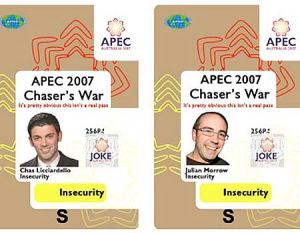RubyKaigi 2011 was really great. My talk was well received, the other talks were great, the atmosphere of RubyKaigi was wonderful, and I had a lovely time in Japan.
Makoto Inoue translated my talk from English into Japanese. On the day, my talk on the Small Eigen Collider was well-attended, and people asked questions, aided possibly by my offering t-shirts! People tweeted and IRC’d about my talk. Some of them even did so in a language I can read!
The talks
I really enjoyed the talks at RubyKaigi. Some were about implementations of Ruby, such as JRuby and MacRuby. Others were about upcoming features of Ruby, such as method shelters, or running tests in parallel. Eric Hodel gave advice on how to write good libraries, while other talks were about the community, such as Shota Fukumori’s talk on school students doing Ruby. There were also talks on concurrency, such as Elise Huard’s “Actors on stage”.
One talk I’ll remember after everything else is forgotten is the parse.y Famtour. By editing one file, he could redefine the Ruby language. He implemented fuzzy logic, possibly doing an action, but maybe not, based on a boolean. He also created a flexible keyword for de-indenting several layers at once. De-indent two levels? ennnd! Three levels? ennnnnd! Five levels? ennnnnnnnnd! This is what I want in a talk – something completely new and unknown!
This isn’t a very complete write-up of the talks, but I’m hoping that subtitles will be done of the talks so I can watch them again.
RubyKaigi itself
The social experience at RubyKaigi was wonderful and unique. You could create an origami Ruby. For the lightning talks, time running out wasn’t indicated by an iPhone app, but by a lady in traditional clothing gonging you.
For lunch, there was an anti-bocchi board, where you could organize to have lunch with other Rubyists. Some Australia-jin (Aussies) tended to have lunch with other Australia-jin, but I wanted to have lunch with Nihon-jin (Japanese). I was always the last one to finish lunch because I was talking so much. That, and because I’m bad at chopsticks – part way through the meal I’d ask foku o kudasai (fork please)!
The goodies I received were very useful. The fan and sweatband were appreciated considering that RubyKaigi was held during summer and that air conditioning was reduced because of of 3/11-related electricity shortages.
The situation with regards to language varied from talk to talk. Some people talked purely in English, some talked in Japanese but had English slides, while with others you had to rely on live translations. These translations appeared on a screen adjacent to the presentation screen and in IRC.
Sometimes the live translations were excellent, and sometimes they were frustrating. To be honest though, the main time language was an issue was when the subject matter was fairly technical, and I was wanting an excuse to ignore the talk and see what’s going on in twitter, such as RubyKaigi trending for the whole of Japan. Occasionally, there was a bit of Engrish – the most notable was “crap your hands”, which they joked about afterwards.
With regards to translating English talks into Japanese, I was one of the few people who took advantage of RubyKaigi’s offer to do so. To not do so is a missed opportunity!
Books were available for sale. I bought a Japanese book on bioinformatics with Ruby which transliterates as “Ruby de hajimeru baioinfomatikusu”, and means something like “beginning Bioinformatics with Ruby”. One day I’ll be able to understand it, but so far I’ve used it as practice for reading kana (Japanese characters that represent syllables). Neither that book, nor any other book on Ruby and bioinformatics, exist in English to my knowledge.
Events were held before and after RubyKaigi. Before the event was JRubyKaigi. At that event, I was talking with someone about the Ikebukuro Earthquake Museum and its simulations, and the next minute, a real earthquake occurred. One person noted “Demos are always experimental and dangerous!”.
After RubyKaigi was Asakusa.rb, and a Github drinkup. I met with Matz during the drinkup, and I talked with him about the fate of the flip-flop operator in a hundred years’ time. Apparently, it may not exist then. I also went around Tokyo with two Rubyists who were from outside of Tokyo (Cuzic and one other person).
Japan

Even the manholes are beautiful (Karuizawa photo)
I visited a variety of places before and after RubyKaigi. The first place I visited was the Ikebukuro Earthquake Museum. It took me a while to find the place, even with my iPhone, because all I could find was the fire department, and I was too shy to ask them for directions for a tourist. It wasn’t until I saw a sign to the museum inside that I realized that the museum was within the fire department!
The museum was very much practical rather than historical. It had an earthquake simulation, where you started off sitting at a table, and when the earthquake started, you had to duck underneath the shelter of the table. To make it a bit scarier, the lights went out a few seconds in, and you could hear a kettle falling to the ground. The next activity was navigating through a smoke-filled series of rooms. You had to remember to be half-crouching, and cover your mouth with a handkerchief. The following activity was CPR. Of course, the Japanese I said to my mannekin wasn’t that good – I said “genki desu?” when others were asking their dummies something slightly more serious to ask if it was ok. At least it didn’t say “mo-ichi do?” back to me! The final activity involved putting out a fire. I only got to use a fire extinguisher, while others got to use a fire hose!
Some of the information was only in Japanese, but the museum staff were very helpful to me, for example checking that I understood what was going to happen in the smoke-filled rooms exercise. They asked me afterwards why I came, and I explained that I was a scientist. Maybe I’m a little bit odd like that. To be honest though, the museum had the advantage of being close to the Ryokan (Japanese-style hotel) I was staying at, such that I didn’t need to take a train.
I visited the Tokyo National Museum . It had a variety of different artefacts, including pottery, calligraphy, weapons, armour, but the thing that I remember the most was the lacquer-work. The amount of work put into a single box made me feel sad. Was it worth the effort?
While I was with the two out-of-town Rubyists, we visited a maid bar in Akihabura, and browsed a few stores there. We saw the palace gardens, and then we visited Tokyo Tower. It described what there is in Tokyo, and had a exhibit where you could look at a map of Tokyo in earlier times compared to now. There was also a gift store where I bought a pair of tea cups. We then went on to Asakusa.rb.
The next day, I wanted to visit somewhere nice outside of Tokyo, and ended up choosing Karuizawa. It is a resort town, and is a bit cooler than Tokyo because of its elevation. It’s also the only town that’s hosted both Summer and Winter Olympic events: it hosted the equestrian events for the 1964 Tokyo games, and curling for the 1998 Nagano games. I saw a famous waterfall called Shiraito Waterfalls (literally “white strings”), and went shopping, buying some sweets for my Japanese class, and a hand-made doll of a cat wearing a kimono.
Travelling by shinkansen was very nice – you don’t have to book a specific time if you don’t want to, and there’s no security screening, but it has the cool things about flying. You can order food, and there’s a shopping catalogue of all things weird and wonderful. My favourite is a device that allows you to set up a desk from the steering wheel of your car. I’m glad I wasn’t driving while in Japan! According to my iPhone, the shinkansen was clocking speeds of 230 kilometres per hour!
The flight to and from Japan on JAL was also very nice. On my flight from Sydney to Tokyo, they upgraded me to an emergency row for free, and the hostesses were very friendly. I loved the anime demonstration of flight safety, and thought it was more informative than standard demonstrations as well. The meal on the flight to Tokyo had an Australian element to them – they had tim tams as a sweet, and meat pie for afternoon tea. However, I have one pro-tip: if you’re 6 foot 4 inches, and you’re wanting to sleep during your flight back home, don’t book a standard seat on lilliput-jin airlines!

Earthquakes cannot stop Japanese trains. All it can do is delay it for a while.
Public transportation in Tokyo was good – information was available in English. The biggest challenge was just logistics, not language: make sure you use the right exit from the station, as the stations are massive, and that you don’t choose a train that goes past your station! While you’re in trains, you can read about reasons for delays with other trains. They were pretty good reasons – one delay was because of an earthquake, while another was due to “bear impact”! I wish Sydney’s Cityrail was that reliable!
Having studied Japanese for 6 months this year, language wasn’t that big a issue. It was a barrier only three times. The first was at a love hotel. I wasn’t able to understand what the receptionist was saying, apart from not being able to get a room. Maybe it’s mandatory that you’re undergoing an illicit affair with someone, whereas I was just a dumb solo tourist that had got locked out of my Ryokan. I’ll never find out. The second was at Mister Donut. I had asked for an interesting-looking drink, but the cashier gave me instructions that I couldn’t understand, so I had to order koka kola kulashikku instead. The third, ironically enough, was with Google transit. I couldn’t work out how to display Romaji names for the train stations or train lines, so I had to rely on the suburb names near the train stations, which were in Romaji. Unfortunately, my Japanese was fairly basic, and I didn’t learn much new Japanese while I was there. Next time I’m there I’ll be good at the language, I hope!
Ennnnnnnnnd!


